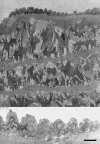Inflammatory events in a vascular remodeling model induced by surgical injury to the rat carotid artery
- PMID: 16299548
- PMCID: PMC1615853
- DOI: 10.1038/sj.bjp.0706472
Inflammatory events in a vascular remodeling model induced by surgical injury to the rat carotid artery
Abstract
1.--The aim of our study was to gain insight into the molecular and cellular mechanisms of the inflammatory response to arterial injury in a rat experimental model. 2.--Rats (five for each experimental time) were subjected to brief clamping and longitudinal incision of a carotid artery and monitored for 30 days. Subsequently, Nuclear Factor-kappaB (NF-kappaB) expression was measured by electrophoretic mobility shift assay. Heat shock protein (HSP) 27, HSP47 and HSP70 were evaluated by Western blot. Morphological changes of the vessel wall were investigated by light and electron microscopy. 3.--In injured rat carotid artery NF-kappaB activity started immediately upon injury, and peaked between 2 and 3 weeks later. Western blot showed a significant increase of HSP47 and HSP70 7 days after injury. At 2 weeks postinjury, HSP27 expression peaked. Light microscopy showed a neointima formation, discontinuity of the media layer and a rich infiltrate. Among infiltrating cells electron microscopy identified dendritic-like cells in contact with lymphocytes. 4.--Our model of surgical injury induces a significant inflammatory process characterized by enhanced NF-kappaB activity and HSPs hyperexpression. Dendritic-like cells were for the first time identified as a novel component of tissue repair consequent to acute arterial injury.
Figures








References
-
- BAILEY A.S., FLEMING W.H. Converging roads: evidence for an adult hemangioblast. Exp. Hematol. 2003;31:987–993. - PubMed
-
- BHATT D.L. Inflammation and Restenosis: is there a link. Am. Heart J. 2004;147:945–947. - PubMed
-
- CERCEK B., YAMASHITA M., DIMAYUGA P., ZHU J., FISHBEIN M.C., KAUL S., SHAH P.K., NILSSON J., REGNSTROM J. Nuclear factor-kappaB activity and arterial response to balloon injury. Atherosclerosis. 1997;131:59–66. - PubMed
-
- CIRRINCIONE C., PIMPINELLI N., ORLANDO L., ROMAGNOLI P. Lamina propria dendritic cells express activation markers and contact lymphocytes in chronic adult periodontitis. J. Periodontol. 2002;73:46–53. - PubMed
Publication types
MeSH terms
Substances
LinkOut - more resources
Full Text Sources
Research Materials
Miscellaneous

